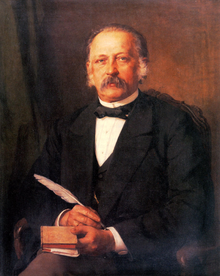Ellernklipp
Ellernklipp (full title: Ellernklipp - based on an old Harz church book ) is a novella by Theodor Fontane (1819–1898), which was first published in 1881.
shape
The novella is divided into 18 chapters with headings, the first eight of which begin with the word "Hilde". The book has around 100 to almost 200 pages, depending on the edition.
content
The novella takes place from 1767 to 1781, shortly after the Seven Years' War on the northern edge of the Harz Mountains . The forest ranger and "Heidereiter" Baltzer Bocholt lives with his son Martin and the foster daughter Hilde Rochussen, the illegitimate daughter of the local count, in the village of Emmerode. Bocholt can act very quickly, which is shown when he unceremoniously shoots a poacher . Both father and son are interested in Hilde, who is attractive in a peculiar way. When Bocholt realizes that Martin and Hilde are in love, jealousy on the Ellernklipp, alder- covered cliffs, leads to a fight, and Bocholt pushes his son into the depths. He returns home and hides his act. He married Hilde three years later. They have a child who is sick. Bocholt shoots himself there because the doctor can no longer help the child and because people say “Father” from the depths of the Ellernklipp. The child dies the same day. Hilde loses her melancholy and is taken in by the Countess, but also dies a few months later. Her tombstone does not have a name, but the saying "The law is eternal and unchangeable".
background
The novella was written in 1879/1880. Ellernklipp is a work from the beginning of Fontane's age period, in which he created his most famous works. At the same time, it is his last work that takes place in the past. Fontane had read in Ilsenburg church registers about the crime that had taken place on the Bäumlersklippe there. In the novella, however, the description of historical events takes a back seat; instead, mythical and psychological aspects are dealt with, such as the father-son motif and the temptation of a woman. Ellernklipp belongs with Grete Minde (1880), Unterm Birnbaum (1885) and Quitt (1890) to the "crime stories" of Fontane because crimes are dealt with there.
The motto of the last chapter and the inscription on Hilde's tombstone, "The law is eternal and unchangeable". If a crime is committed and justice fails, it will be atoned for . All four crime stories are based on this principle.
The language of the common people in the novella is Low German , but not in the East Westphalian form as it was spoken in the Harz Mountains at that time.
Besides Quitt, Ellernklipp is the only narrative work from Fontane's second half of life that was not made into a film.
reception
“'Ellernklipp' is undoubtedly not one of Fontane's main works, it is more or less a by-product. But the narrative still emanates a secret charm, which is also evident in the brief psychological portrayal of the characters, in the peculiar combination of mythical and psychological elements, above all in the 'magic' of this young woman, as well as in the scenic ambience of the Harz Mountains and of course in that underlying criminal case is expressed. "
“Despite all the differences in material, Fontane's crime stories show striking structural similarities, a rational construction plan. One has observed 'analogous situations and characters', 'as if a four-fold mosaic were created from the same pieces of glass'. Nevertheless, the degree of success and interest that these narratives are still able to attract today are very unequal. Ellernklipp seems to have become completely indifferent . "
expenditure
- Ellernklipp. May and June 1881; nine chapters each in Westermann's monthly issues (issue 32, pp. 145–180 and issue 33, pp. 273–304).
- Ellernklipp. 1881, first book edition by Wilhelm Hertz , Berlin, 177 pages
- Numerous further individual issues and parts of complete issues
Web links
- Ellernklipp in the Gutenberg-DE project
- Full text at zeno.org
- Figure lexicon for Ellernklipp by Anke-Marie Lohmeier in the online literature lexicon portal .
- Klaus Hammer: “Legal amendment with atonement?” At berlinerliteraturkritik.de
- Eroticism in Theodor Fontanes Ellernklipp (seminar paper at the University of Innsbruck , PDF file; 251 kB)
Individual evidence
- ↑ a b c “Legal amendment with atonement” at berlinerliteraturkritik.de , accessed on May 20, 2011
- ^ HFF Potsdam, List of Fontane films up to 2011 ( Memento from March 28, 2013 in the Internet Archive ), accessed on May 21, 2011
- ^ Helmuth Nürnberger: Fontane. 23rd edition. Rowohlt, Reinbek 1998, ISBN 3-499-50145-7 , p. 134
- ↑ Google Books, p. 500 , accessed May 20, 2011
- ↑ a b Edition history of Ellernklipp , accessed on May 21, 2011

